Introducing The Ranger
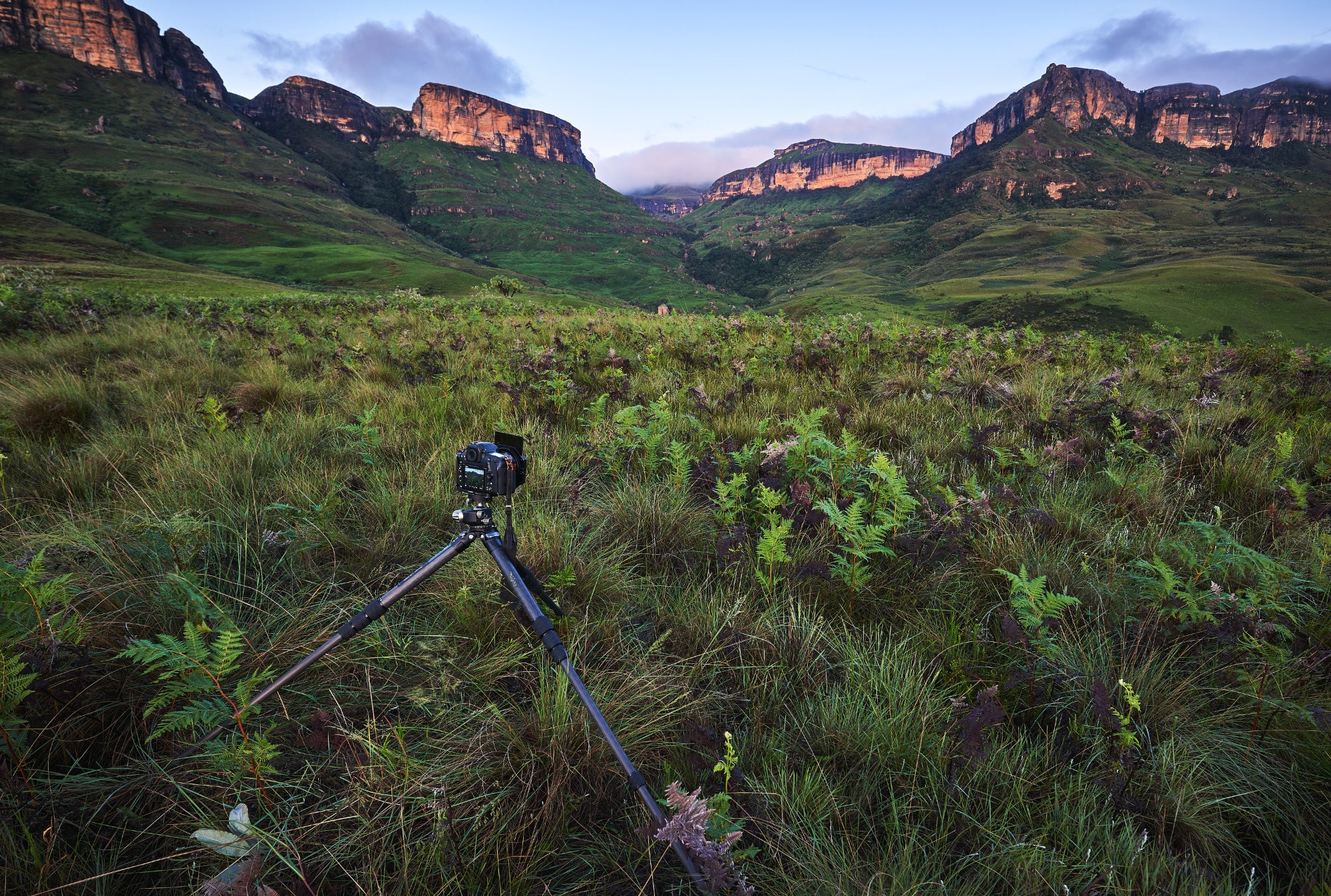
It would seem there isn’t that much to a tripod: three legs and a head that allows attachment to a camera. Yet there is a veritable plethora of designs, and price ranges to match, available. Unfortunately, and thanks to the vast array of choices and price option, for many photographers, the first tripod that they buy is the wrong tripod for them. Either it is too lightweight - or poorly made - to actually support their camera, or is so heavy that they never carry it with them, and therefore never use it when they should. The invariable purchasing process is that keen and active photographers go through several tripods before they settle on one that they are happy with. This is a process that usually costs a significant amount of money and can leave a bitter aftertaste that results in the tripod being used less than it should.
Yet, one of the most important pieces of equipment that a photographer can own is a tripod. I wouldn’t be lying if I said that more than 50% of the images I make are with the camera secured to a tripod, and closer to 90% (if not higher) of the landscape and architectural images I shoot, are with a tripod. I am not exaggerating when I say that a good tripod and head is imperative to the photography that I do. Since so much of my photography requires a tripod, I prefer using a stable, large but lightweight tripod that does not weigh a ton to carry and has a similarly excellent, easy to use head as well that can easily support the equipment I use without sagging or being difficult to position.
I have had the privilege (or misfortune) to have used (and owned for many of them) tripods from Manfrotto, Gitzo, Sirui, Velbon, Vanguard, FLM, Benro and even Really Right Stuff (loaned as opposed to owned in this case) as well as had more than a passing acquaintance with Mefoto, Three-Legged Thing and Benbo. Amongst them are some truly brilliant tripods; ones which were a pleasure to use, and others which were terrible and useless at doing the one thing that they were supposed to do; which is holding the camera steady. Yet, there has always been a caveat of some sort, a niggling sense that there is a compromise made in the selection of that tripod.
Then I came across a tripod I hadn’t seen or heard of before while leading a workshop in Iceland. The photographer using it enthused over its ability, weight and price (for price is often the deal-breaker for many photographers when they select a tripod and head). It was a Leofoto Ranger! My interest was piqued. So when the team at Landscapegear mentioned the possibilities of bringing in a new brand of tripod into South Africa, I jumped up and down at the opportunity to become more acquainted with Leofoto and their incredible range of tripods and heads.
About Leofoto

Leofoto is a relatively young brand out of China, started by a team of engineers that have had extensive experience in manufacturing tripods for other brands. Read what you want to out of that, but Leofoto do conduct their own research and do have some unique original designs, although some of their designs will look similar to other brands that no longer hold patents over those designs.
Some photographers might be sceptical about a brand originating from China. Personally, I am not. Brands like Nisi and Laowa have more than proven that Chinese photographic brands can more than compete with, and often best, their European and American counterparts. In some cases, like DJI, the Chinese company literally dominates the industry and is essentially the trendsetter to watch (industry analysts would argue that Huawei is similar in this regard). I have been blown away by the quality of Nisi glass and use and swear by the Laowa products I own and use. My test of whether a piece of equipment is ‘the best’ is whether, given the opportunity to select any piece of gear, I would still select it. My Laowa 12mm is an example of this, as are the Nisi glass filters that I use. There is also the fact that a great many of the high-end products we use, although ostensibly European or American, are actually manufactured in China (my F-Stop bags which are supposedly American are a case in point). I have also had similar experiences with other Chinese tripod brands, Sirui in particular. This is not to say that there isn’t rubbish out there, there is, but Leofoto is most definitively not that.
Founded in early 2014, the Zhongshan Laitu Photographic Equipment Co., Ltd (to give Leofoto its full name) is still relatively small, but has a factory capable of producing and testing up to 1000 tripods a day. Being young, they are still innovating their products so we can probably expect some interesting and exciting products to come (they have showcased a titanium prototype for instance, where the spider and leg angles are made from titanium rather than machined aluminium).
Attached to all Leofoto products is a rather ambitious 10-year guarantee. It’s worth mentioning that the guarantee extends to faulty parts and workings as opposed to standard wear and tear. A well known British landscape photographer that I worked with estimated that his tripods probably only lasted three years before they had to be replaced. Any tripod used on a daily basis in severe conditions (think salt spray, seawater, ice, snow and desert sand) is gradually going to be destroyed. How you treat your tripod determines how long it survives, or how quickly it is destroyed. Regardless though, a guarantee is only as good as the distributor of that particular product. Landscapegear, the South African distributors have already built a solid reputation as the distributors of Nisi, Laowa, F-Stop and Gitzo. Unlike a lot of other countries where Leofoto still doesn’t have an official presence, at least in South Africa you know there is solid support behind the Leofoto brand if something goes wrong.
The Ranger
The Ranger is a different kind of tripod to hit the market. Unlike most other tripods it lacks any centre-column (apart from one model in the range). As a result, its packaging dimensions are a lot narrower than other tripods, it is lighter, cheaper and a simpler design means improved stiffness, easier maintenance and a longer lifespan. The lack of a permanently attached centre-column also means that the Ranger folds down to a much smaller ‘footprint’ than reversible column travel-tripod designs (like the Gitzo GT series). Despite not having a standard centre column, the Ranger does come with an included modular centre-column, so you still get the added height of a centre-column, but the improved stability when you opt not to use it. From the outset then, the Ranger is targeted to travel and landscape photographers who need portability without compromising on stability.
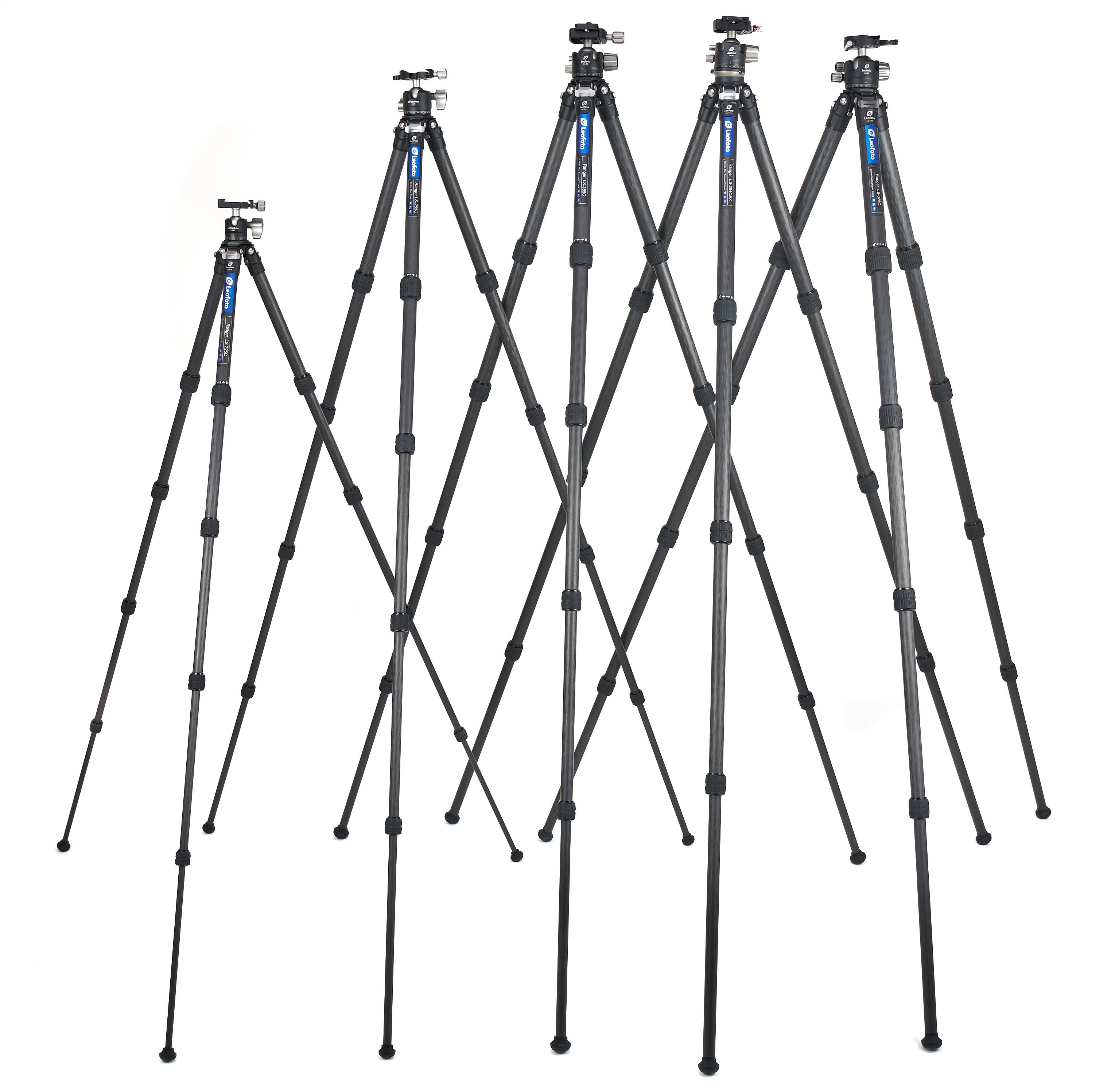
Four of the five series of Ranger shown above with (from left to right) the LS-225C, LS-255C, LS285C, LS-284CEX and LS325C (not pictured is the largest of the set, the LS365C which has a top leg section diameter of 36mm).
Construction
All of the Ranger tripods have leg tubes constructed from 10x Carbon Fibre manufactured by the Japanese manufacturer, Toray industries (the ball-bearings in the tripod heads are also Japanese manufactured). The number describes the layers of carbon fibre weave. In theory the more layers there are, the more rigid and strong the final tube. Although all tripod manufacturers like to announce the number of carbon-fibre layers they use, they keep the fibre and resin ratios secret, as this is possibly more important in determining rigidity and strength. Interestingly the Chinese brands like Sirui have been early adopters of 10x Carbon Fibre with the more well-known brands seeming to follow in their steps as opposed to what one usually assumes as the Chinese companies copying their European competition.
The spider/apex and other metal components like the leg locks and angle stops are all made from aircraft-grade machined hard anodised aluminium. Connecting the leg angles are stainless steel pins and solid brass washers. Nicely ribbed soft rubber grips encase all the leg locks. In use, I found that they didn’t slip on the metal below. At the bottom of the legs, the tripod feet can be switched out from the thick rubber feet to stainless steel spikes (included with the tripod). The rubber feet are bulb-shaped with bevels to correspond with the leg angles. Interestingly, the feet are more than just a bulb of rubber. The rubber encases a hollow core aluminium foot designed to reduce weight and improve stability (full rubber has a tendency to ‘bounce’ the tripod in an almost imperceptible jiggle that can be picked up at certain shutter speeds). Most photographers probably won’t bother with the leg spikes. Personally, if spikes are a requirement I would recommend rather getting the claw feet.
Features
At the heart of a tripod is the apex, also referred to as the spider. This is the metal shoulder where the legs join at the top hinge and the head is attached. Like all other high-end tripods, the spider on the Ranger tripods is made from solid aircraft-grade aluminium that has been hard anodised with a powder black coating. The spider is hollowed in various places to lighten the overall weight without compromising strength. There are three angled grub-screws that can be tightened to lock the ball head in place. However, I found that a decent turn on the head and it didn’t loosen inadvertently while in use.
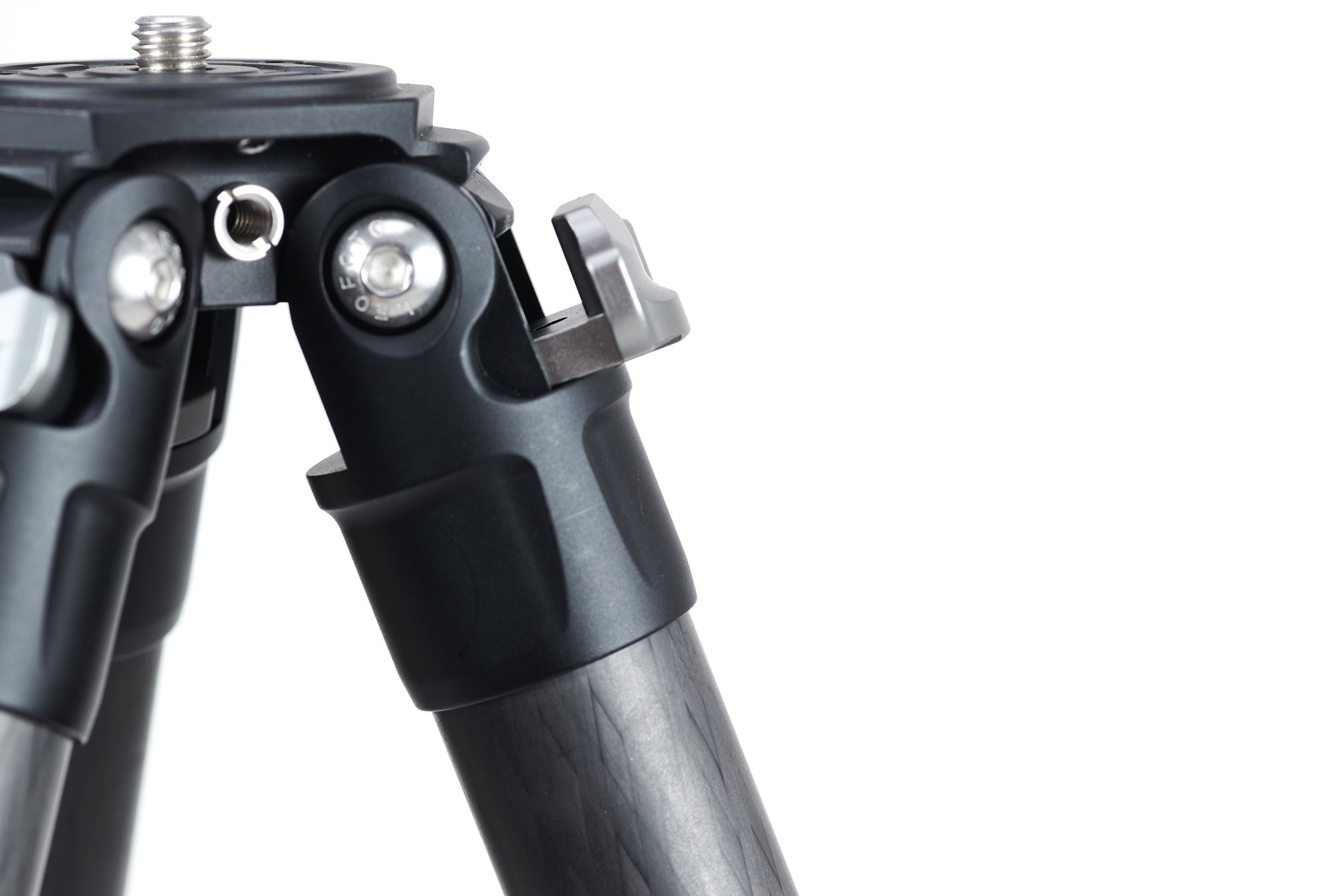
The leg angle locks have three settings with an easy to grip, self-locking angle lock. On one side between two of the legs is a universal 1/4 inch screw thread to accept a range of accessories. Leofoto has quite an extensive range of accessories from flash arms to cell holders than can plug into this 1/4 inch thread. For instance, the ball joint magic arm attached to a cellphone holder means that photographers can timelapse with their phone while they shoot, or alternatively shoot video or vlog from the same platform that they are photographing from. Underneath the spider is another 1/4 inch screw thread to accept accessories or a weight hook which is included with all of the tripods (although this is not on the levelling Ranger legs).
On any tripod design, the centre column is probably the weakest link. For this reason, a lot of landscape photographers eschew centre-column designs and opt instead for the larger and heavier systematic tripods. At issue for many of these photographers is that the systematic tripods tend to have a much wider packed diameter since they have to incorporate a large hollow gap in the centre of the spider in order to accommodate optional centre-columns as well as half-bowls and self-levellers for video use.
The Ranger manages to slim down the diameter of the tripod by completely removing any gap for a centre column from the spider. Not all photographers are going to love this design feature, but it comes with some phenomenal benefits that landscape and travel photographers, in particular, are going to love. The most dramatic difference that this makes is on the diameter of the tripod when folded for packing. A traditional 3 series tripod (i.e. a tripod with the top leg section having a diameter of 30mm or larger) has a folded diameter of between 120-130mm. The LS-324C, which has a top leg section of 32mm had a folded diameter of 96,5mm. Admittedly 3cm doesn’t sound like a lot, but when packing a tripod, it’s an enormous difference as the space between the legs - usually an empty void - is essentially done away with. It will make packing for air travel significantly easier for a start, but also makes the tripod more streamlined when attaching it to the side of a bag like the F-Stop series of bags.
Although there is no hole for a centre column, Leofoto does still provide an option of getting higher off the ground with an optional (and included in the purchase) screw-on telescopic centre column. The idea is that on the rare occasions that you do need the additional height of a centre-column you can quickly screw in the accessory between the head and the legs. This might sound odd, but I actually found it very simple in practice. The screw-on centre columns were very stable, far more so than I expected actually. Personally, I think the inclusion of a screw mount centre column allows for a bias towards stability and rigidity. Conventional centre-columns are the weak point on a tripod, even when they are lowered. This means that the Ranger should be more stable than a tripod with a centre column when the centre column is lowered. With the screw-on centre column attached to the tripod, it should compare equally to a raised centre column. After use, I have to say that I am personally a convert for field photography, although in a studio setting I would prefer a centre-column (but then I would use a systematic tripod with a centre column in the studio).
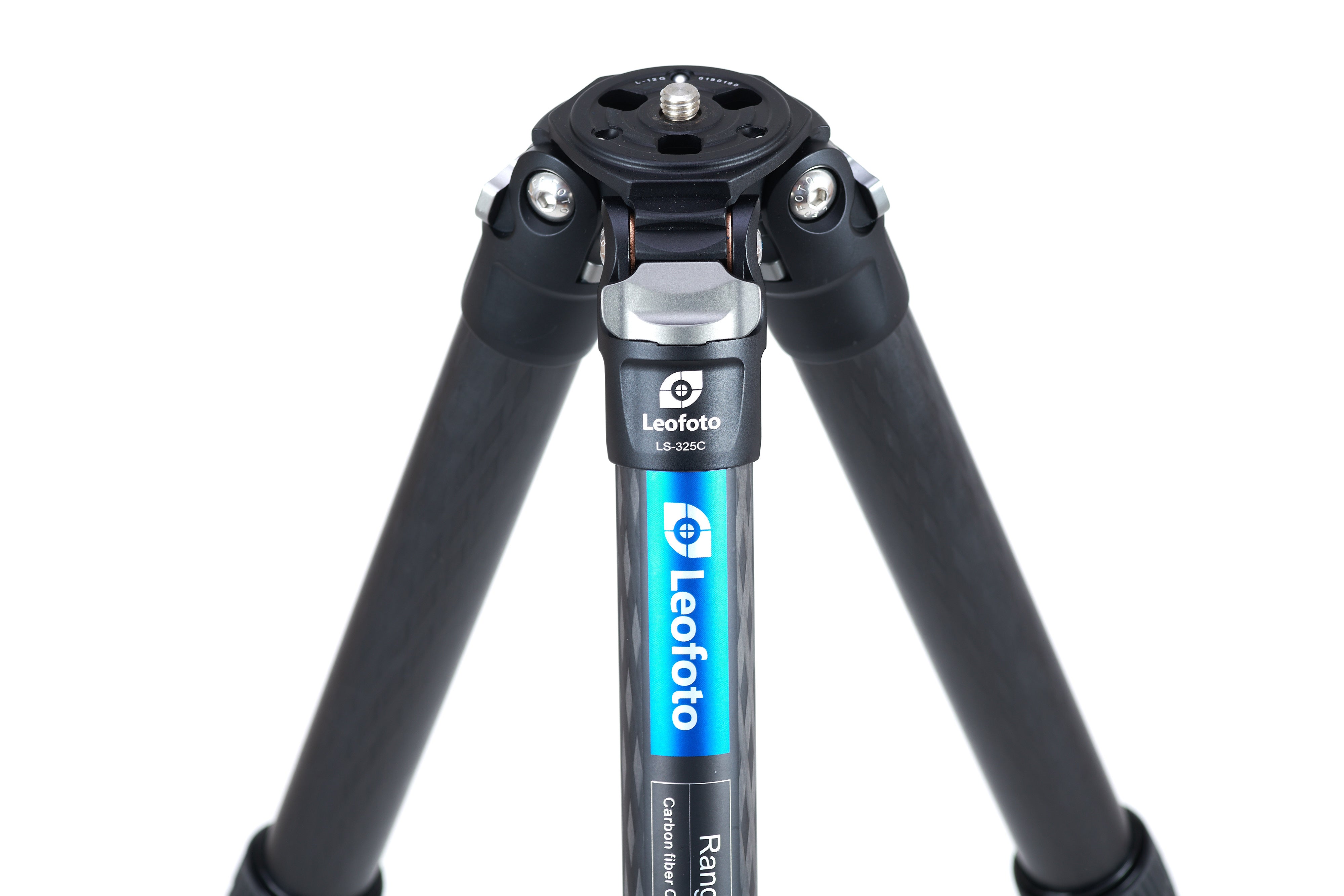
The spider on the LS-325C showing the lack of centre column, and narrow profile. The hollowed-out design is also visible, as are the large and easy to pull leg angle stops.
Leg spread angles on the Rangers are 23, 55, and 85 degrees (published). It is important to note that the primary angle on the Ranger is slightly narrower than the angle one usually finds on a tripod of this class. With the heavier tripods of the range, this is basically a non-issue. With the lighter tripods such as LS-225C and LS-255C, it can mean that the support in a strong wind can be compromised (to be fair any tripod of this weight class should be weighted down with the use of the weight hook). The upshot of the narrower primary angle is that the tripod is marginally taller without the centre column.
The rest of the features on the Ranger tripods are what you would expect to find on a refined high-end tripod. Standard twist locks are found on the tubes. Internally there is a single piece user-replaceable shim that stops the leg tubes from rotating or falling out (single piece are far superior to earlier designs on some other tripods of two-piece shims that would fall out with wear). Leg angles are set with a self-correcting angle lock at the top of the leg. The angle pulls are beefy aluminium grips that are easy to pull out and return with a satisfying and audible click when you close the legs again.
As mentioned above the Rangers all have removable rubber feet that can be swopped out for short stainless steel spikes. The rubber is fairly soft and grippy, so will work in the vast majority of uses (apart from hard ice probably, and potentially some slick sea rocks - both cases where the optional claw feet or included spikes would be a better use).
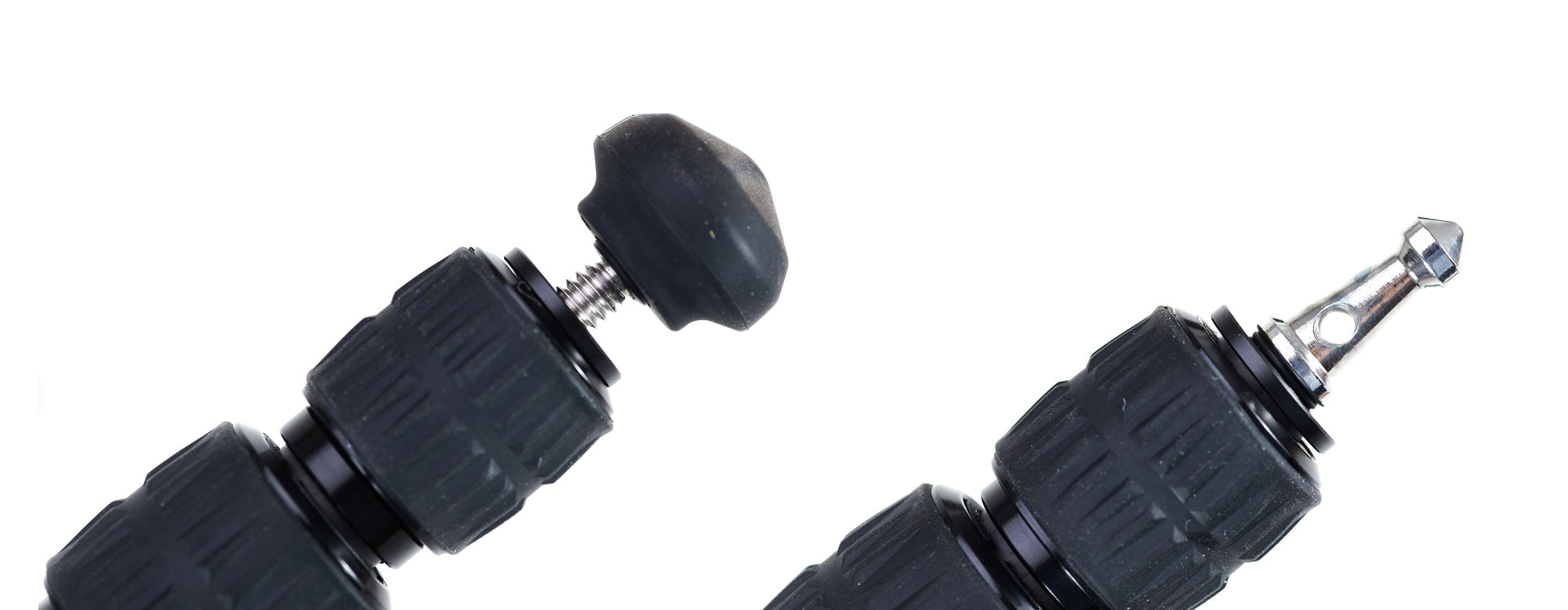
A Special Kind Of Ranger
Unique to Leofoto Rangers is a speciality tripod with landscape photographers and filmmakers in mind: the Levelling Ranger. This Ranger comes equipped with a built-in half ball levelling unit. Available from the series 1 upwards, this leveller has a protruding locker switch and level that is also easily visible with a head attached. Without actually going into a review of the product the levelling head on the LS-284CEX that I used was one of the simplest, easy to use, and effective levelling bases I have ever worked with.
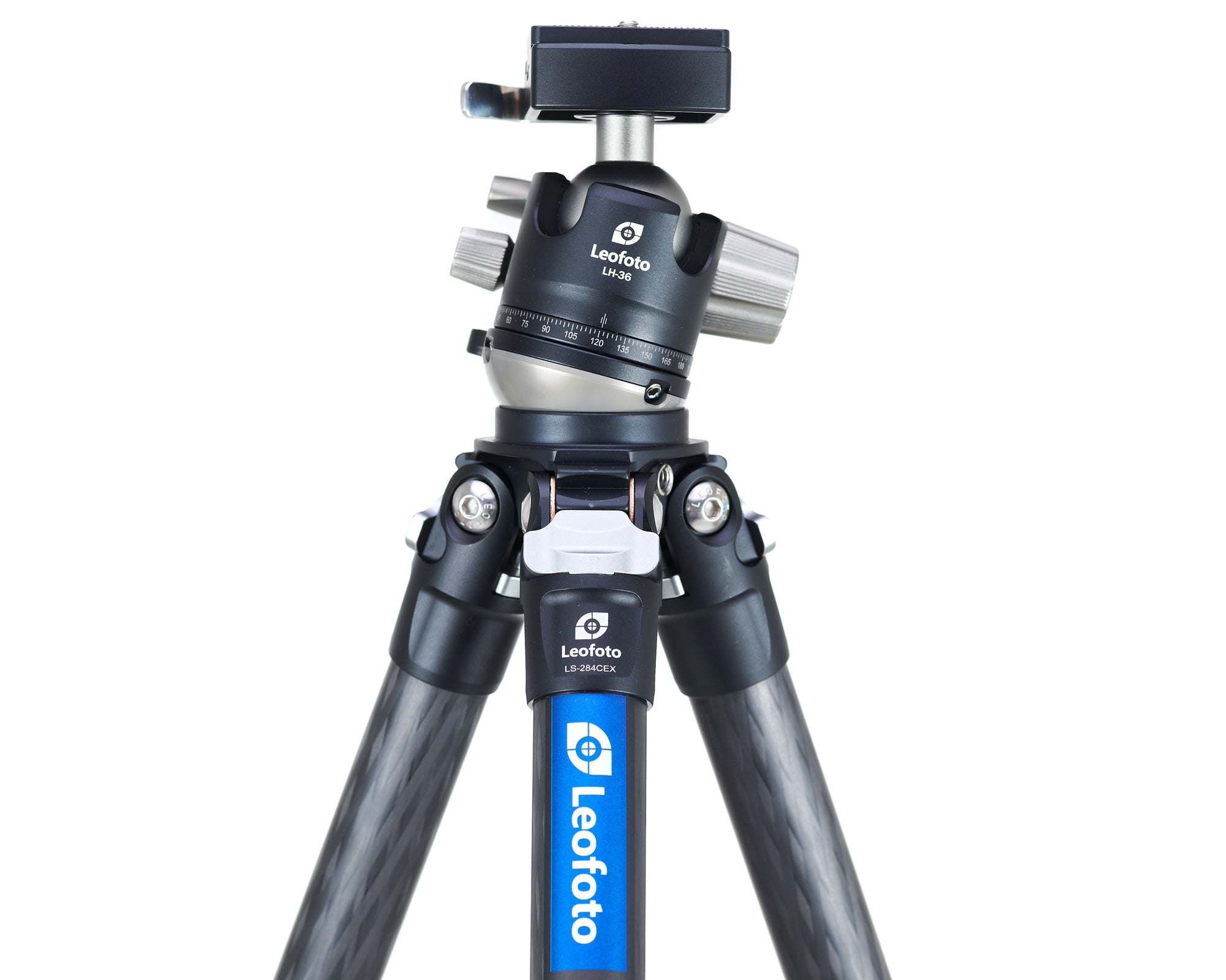
The importance of a levelling base for panoramic photography cannot be understated. Panoramic stitches are always easier to achieve if the base of the tripod head is levelled. A levelling base is the easiest and most effective way to level the base of the tripod head. There is a range of products on the market that can be inserted between the head and the tripod spider (Leofoto also makes these type of 'levellers'). With systematic tripods, there is also a larger dedicated levelling base that sits in a half-bowl adapter (included with all summit tripods). However, these options all add weight and complexity to the tripod setup. The Ranger, staying true to the ideal of minimalist weight, builds the leveller into the CEX models.
If you plan to shoot a lot of panoramas, or video that requires quick setup, the levelling Rangers are an amazing product that is truly unique (although probably not for long as Leofoto is likely to be copied).
Understanding the Options
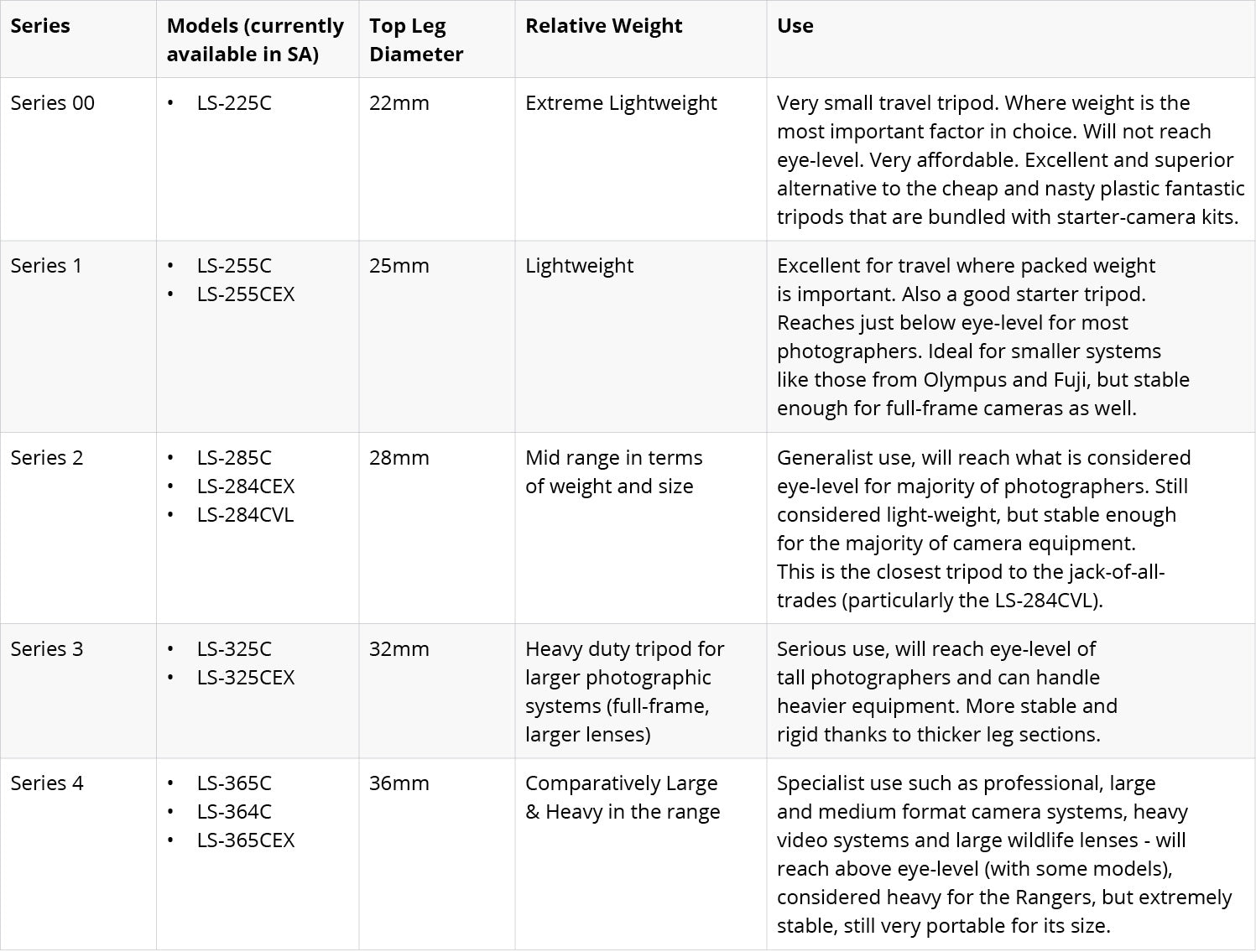
The Ranger tripods come in a diverse range of sizes and lengths. Understanding the naming convention for each of the models is probably the easiest way to understand what each one does, as it’s pretty broadly advertised as the model name.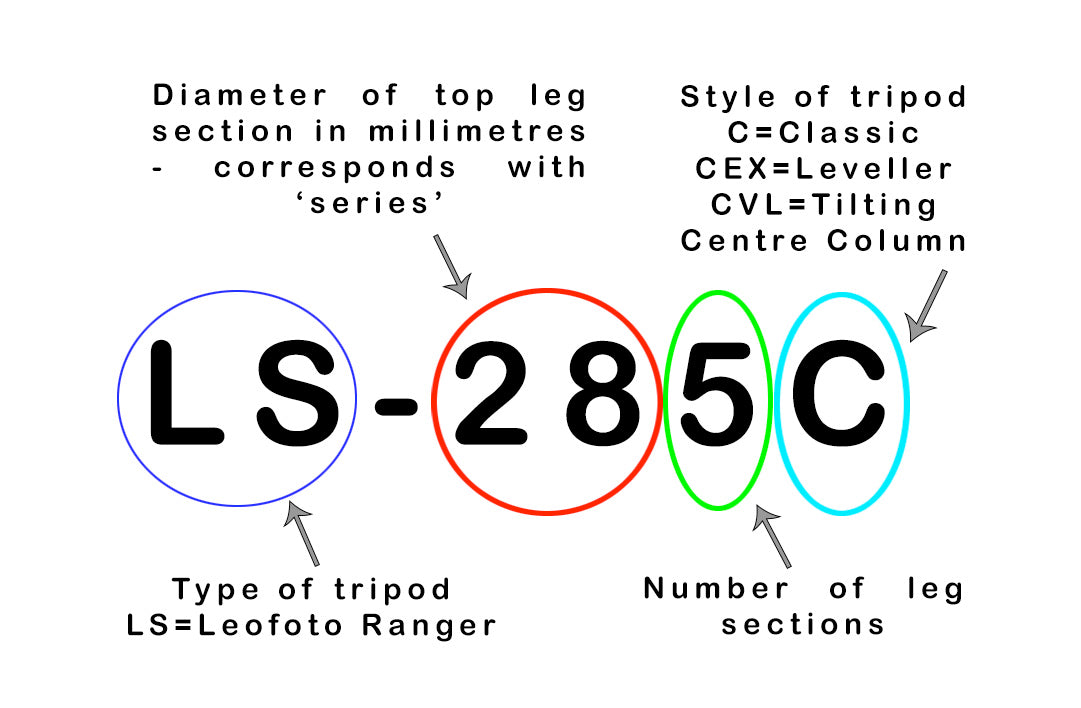
All Ranger tripods start with the code ‘LS’ (the other tripods in the Leofoto range are identified as LX for the Urban Range and the Summit Range are LM). The next two digits refer to the diameter of the thickest leg section. The third digit references how many leg sections there are. The last letters then refer to the tripod type, so C refers to the classic style, CT to the 'traveler' style (the legs fold up over the head - only the case for the ‘Urban’ range of tripods, CEX for the ‘leveller’ tripods that have a built levelling platform, and CVL for the independent angled (tiltable) centre column (ala the old Benbo and the Gitzo Explorer tripods).
The Rangers come in 5 top tube diameters of 36mm, 32.5mm, 28mm, 25mm and 22mm(This is what most manufacturers refer to as the 4,3,2 etc. series). Most of the range also have leg section options of 5, 4 and 3 leg sections to choose from. The largest and heaviest with the greatest height is the LS-365C which reaches to 1520mm and can handle a weight of up to 20kg. The smallest (not including tabletop tripods) of the Ranger tripods is the LS-225 which reaches up to 1201mm and handles 4kg of weight (the showstopper here is its weight and size of 0,75kg and a folded length of only 450mm with head - it will literally fit in a camera bag).
The range of leg diameters is very similar to what competing brands of tripod term their ‘series’, with the narrowest leg section of 22mm corresponding to a series 00, and the largest top section of 36mm corresponding to a series 4 tripod.
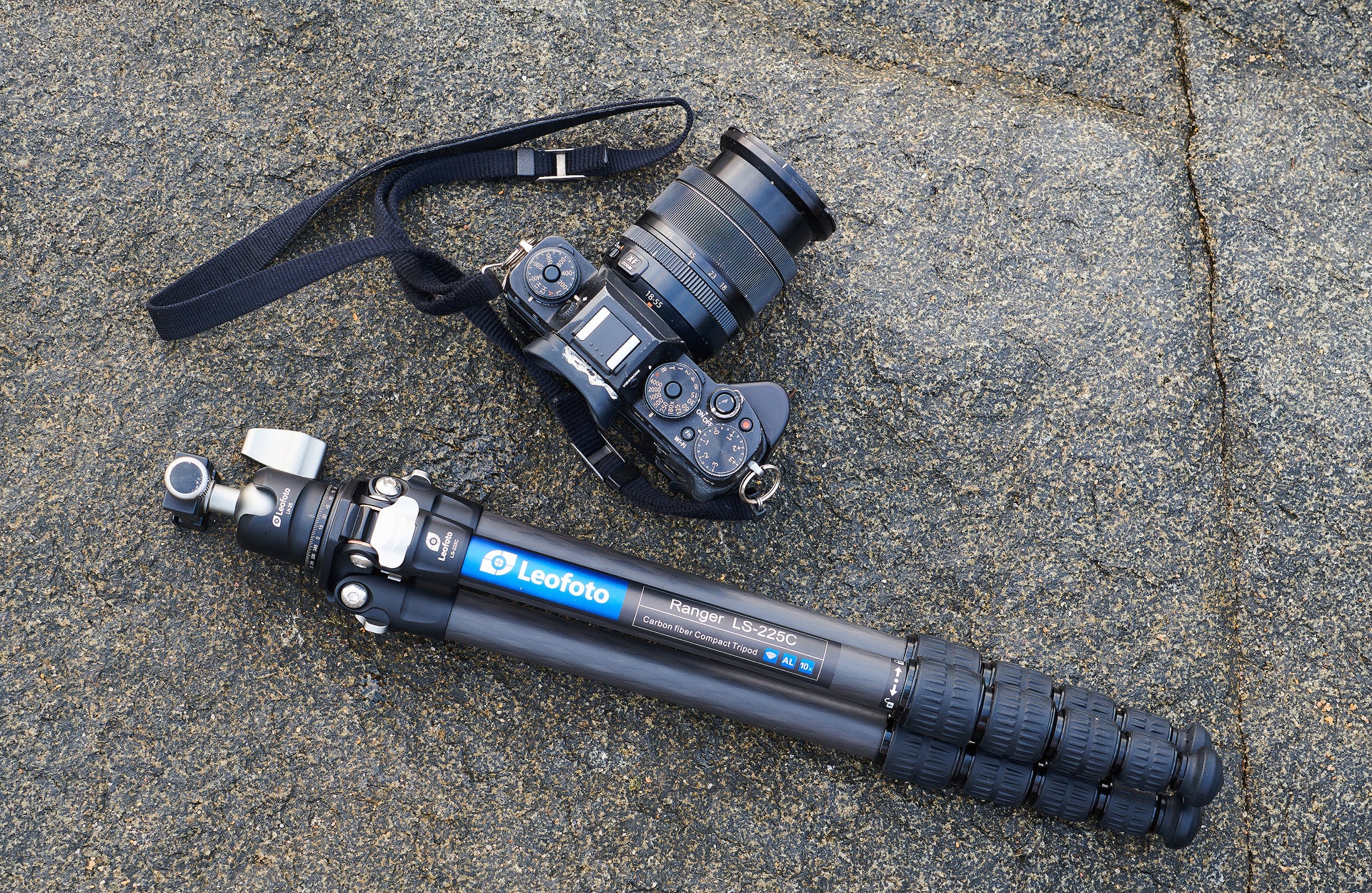
The LS-255C with LH-25 head shown next to a Nikon D850 with 70-200mm f4 for comparison.
Comparisons
Perhaps the easiest way to look at the Rangers would be to consider the tripods against some of the competition.

There are a vast number of tripods on the market internationally. Here in South Africa though, that number is diminished somewhat to Manfrotto, Gitzo, Sirui, Benro, Mefoto, Vanguard, Velbon and now Leofoto. Manfrotto has tended to have a strong market share due to their history in the country. A lot of photographers can remember their parents had a Manfrotto, and most of the colleges and universities had Manfrotto at hand. Similarly, Gitzo has for decades been recognised as the premium tripod brand in the country (interestingly both Manfrotto and Gitzo are actually owned by the same umbrella company, the Vitec Group, which also bought out the American company Bogen). The popularity of Manfrotto is a testament to decades of excellent marketing. In the last 20 years though there have been some truly excellent tripods that have appeared that best the Manfrotto in both features and price, and by a large margin. Just because your parents had one, doesn’t mean they are the still the only tripod around.
Why Choose The Ranger?
The Leofoto Ranger tripods have been designed ground-up as lightweight travel and landscape tripods. They are not designed to be the one-size-fits-all solution (although I have to admit that they come very close and the LS-284CVL really does tick the one-size-fits-all box). Leofoto has other ranges which suit different needs. If you need a travel tripod design with a retractable centre-column, there is the Urban Range. If you need the large systematic tripod that can accept a centre-column or a video bowl for extremely heavy rigs, then there is the Summit Range. Although the Ranger will fit into any photographic environment where a tripod is needed, it is decidedly oriented towards someone who wants a portable, lightweight but sturdy set of tripod legs. The Ranger has been designed to be carried somewhere to shoot, as opposed to set up permanently in a studio.
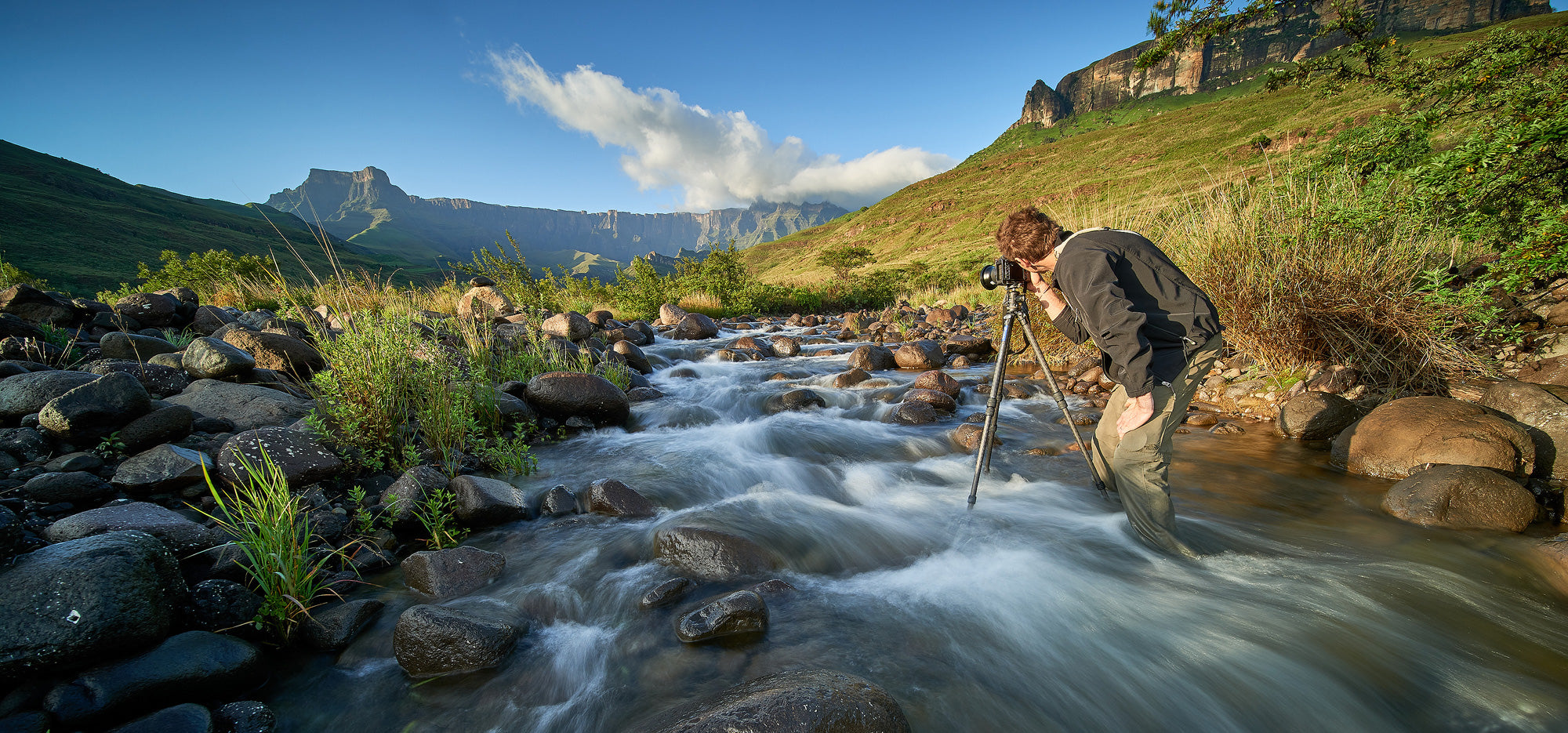
Using the LS-284CEX with NB-32CVL head in the Drakensberg
There are four criteria that one should use when selecting a tripod. These are size, rigidity/stability, weight, and price. Ordinarily, it is difficult to get three out of those four, let alone all four together. So, for instance, you could opt for optimal numbers with size, weight and rigidity, but that would come at a hefty price point. Or, you could opt for a lower price point, but then have to sacrifice on the weight that you would have to carry.
Leofoto has made an incredible effort in allowing for all four criteria, with the proviso that there is no rapid centre-column (apart from with LS-284CVL). Considering any of the Rangers within their series class, each tripod ticks the boxes of top performer in their weight, size (particularly in packed size, which is what matters to many travel and landscape photographers), rigidity and price. The Rangers come in at an astounding fraction of the cost of their European/American competition. For the South African market, in particular, the Rangers are an exciting an option for landscape and travel photographers who need excellent tripods but have a Mickey Mouse currency to contend with. The Rangers offer top-end specifications and performance at a realistic price-point for our Rand.
There will be upcoming reviews of individual Leofoto tripods in the coming months from a number of South African photographers. My experience so far though, has been nothing but positive. The Ranger tripods, in particular, are a breath of fresh air for photographers needing a stable but lightweight tripod that is easy to travel with. Meanwhile, the Leofoto heads (which are not written about here) are among the best tripod heads I have used. If you need a new tripod, the Leofoto Ranger series should be at the top of the list.
Leofoto Tripod Kits
Leofoto Ranger Tripod Legs
Leofoto Ranger Levelling Tripod Legs
Emil von Maltitz is a professional landscape and commercial photographer who spends most of his time photographing industry and agriculture for clients like Tongaat Huletts. You can find his incredible body of work here.